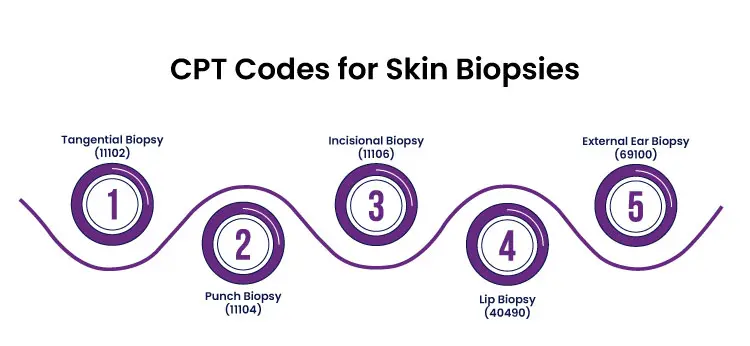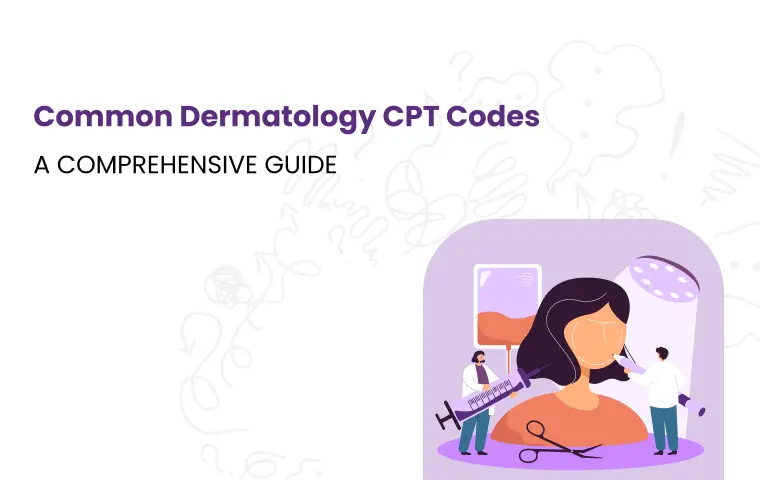As a dermatologist, you're an expert in diagnosing and treating skin conditions. But are you equally confident when it comes to billing for those services? Let's face it, CPT codes can be a real headache.
We have put together this essential guide specifically for busy dermatologists like you. We'll cut through the jargon and focus on the most common codes you'll encounter daily. From biopsies and excisions to those tricky E/M codes, we'll break it all down in a way that's easy to understand and apply.
Consider this your cheat sheet to accurate billing and maximum reimbursement. Armed with the right knowledge, you can do anything. Let's get started!
CPT Codes for Skin Biopsies
When a suspicious spot or lesion appears on your patient's skin, a biopsy is often the first step toward diagnosis. But did you know that there are specific CPT codes for each type of biopsy you perform? Let's break down the most common ones:

Tangential Biopsy (11102)
This code covers biopsies in which you shave or scrape off the top layer of skin. This procedure is ideal for superficial lesions and can be performed quickly in the office. Each additional lesion biopsied in this fashion is billed with code 11103.
Example: A patient presents with multiple actinic keratoses (AKs). You shave off each lesion for biopsy. You would bill 11102 for the first AK and 11103 for each additional AK biopsied.
Punch Biopsy (11104)
A punch biopsy involves using a circular blade to remove a deeper, cylindrical sample of skin. This is often necessary when you need to examine both the epidermis and dermis. Each additional lesion biopsied in this fashion is billed with code 11105.
Example: A patient has a suspicious mole on their back. You perform a punch biopsy to assess for melanoma. You would bill 11104 for this procedure
Incisional Biopsy (11106)
An incisional biopsy involves removing a wedge of tissue using a scalpel. This technique is often used for larger lesions or when you need to sample multiple layers of skin. Each additional lesion biopsied in this fashion is billed with code 11107.
Example: A patient has a large, irregular patch of skin on their arm. You perform an incisional biopsy to rule out skin cancer. You would bill 11106 for this procedure.
Lip Biopsy (40490)
This code is specific to biopsies performed on the lip mucosa. Due to the unique anatomy and healing considerations of the lip, this procedure has its own dedicated code.
Example: A patient has a persistent ulceration on their lower lip. You perform a biopsy to determine the cause. You would bill 40490 for this procedure.
External Ear Biopsy (69100)
This code covers biopsies of the external ear, including the auricle (the visible part of the ear) and the external auditory canal.
Example: A patient presents with a suspicious growth on the helix (outer rim) of their ear. You perform a biopsy to rule out skin cancer. You would bill 69100 for this procedure.
Important Consideration
-
The size of the biopsy site doesn't affect the CPT code selection. The code is determined by the technique used (tangential, punch, or incisional).
-
You can only bill one primary biopsy code (11102, 11104, or 11106) per patient encounter. Additional lesions biopsied with the same technique are billed with the add-on codes (11103, 11105, or 11107).
CPT Codes For Lesions Excision
Beyond biopsies, excisions are another common procedure in dermatology involving the complete removal of a skin lesion.However, choosing the right CPT code can be tricky, as it depends on various factors like lesion size, location, and complexity of the excision.
Excision of Benign Lesions (11400-11446)
This range of codes covers the excision of benign skin lesions, such as moles, cysts, lipomas, and dermatofibromas. The specific code you use depends on the excised diameter of the lesion and its anatomical location (e.g., trunk, arms, legs, face, etc.).
Excision of Malignant Lesions (11600-11646)
These codes are used for the excision of malignant skin cancers, including basal cell carcinoma, squamous cell carcinoma, and melanoma. Similar to benign excisions, the code selection depends on the excised diameter and anatomical location.
Cryotherapy CPT Codes
Cryotherapy, using extreme cold to destroy unwanted tissue, is a versatile tool in dermatology. It's often used to treat warts, skin tags, actinic keratoses, and other benign lesions.
17000: Premalignant Lesions (First Lesion):
This code applies to the first benign or premalignant lesion destroyed using cryotherapy during a patient encounter. This includes common skin conditions like warts, actinic keratoses (AKs), seborrheic keratoses, and molluscum contagiosum.
17003: Premalignant Lesions (Each Additional Lesion):
For each additional lesion destroyed in the same encounter, you'll bill this code. The number of units billed corresponds to the number of additional lesions treated.
Example: If you treat a patient with 5 actinic keratoses using cryotherapy, you would bill 17000 once (for the first lesion) and 17003 four times (for the four additional lesions).
17110: Destruction of Benign Lesions (First Lesion):
This code is used for the destruction of the first benign lesion in an encounter using cryotherapy. It's important to note that this code is typically not used for larger or more invasive skin cancers, which often require surgical excision.
17111: Destruction of Benign Lesions (Each Additional Lesion):
Phototherapy CPT Codes
Phototherapy, or light therapy, is a valuable treatment option for various skin conditions, from psoriasis to eczema.
96910: Photochemotherapy
This code covers the administration of photochemotherapy, a treatment that combines light therapy with a photosensitizing medication. It's commonly used for conditions like psoriasis, vitiligo, and cutaneous T-cell lymphoma.
Example: A patient with severe psoriasis receives psoralen plus ultraviolet A (PUVA) therapy. You would bill 96910 for each treatment session.
96912: Phototherapy Without Photosensitizers
This code is used for phototherapy treatments that don't involve the use of photosensitizing medications. This includes narrowband UVB (NB-UVB) therapy, which is often used for psoriasis, eczema, and vitiligo.
Example: A patient with eczema receives NB-UVB therapy three times per week. You would bill 96912 for each treatment session.
Evaluation and Management (E/M) Codes for Office Visits
While procedures like biopsies and excisions are crucial in dermatology, don't overlook the importance of billing for your evaluation and management (E/M) services. A new patient presents with a complex rash requiring extensive evaluation, diagnosis, and treatment planning. This would likely warrant a higher level of service, such as 99204 or 99205.
An established patient returns for a follow-up visit after starting a new medication for acne. If the visit is straightforward and requires minimal MDM, you might bill 99212 or 99213.
Dermatology Coding Guidelines
While many CPT codes remain consistent from year to year, dermatologists must stay vigilant about any changes that could affect their reimbursement.
CPT codes for biopsies (1110x series) and excisions (114xx, 116xx) remain largely unchanged. However, staying updated on minor descriptor revisions is essential.
New codes 88375 and 88379 specifically address remote digital pathology services, reflecting their increasing role in diagnostics.
Minor revisions exist in codes 15271-15278, so double-check these if they're part of your practice.
Tips for Accurate Dermatology Coding
-
Detailed notes are your best defense against audits. Clearly record the type and extent of services, time spent, and medical necessity.
-
The AMA's CPT manual is your bible. Regularly review updates and seek out reputable coding resources like the AAD's Coding Resource Center.
-
Periodically review your coding practices to identify errors, ensure compliance, and optimize reimbursement.
-
Each payer may have nuances in how they interpret codes and modifiers. Familiarize yourself with their specific guidelines to avoid denials.
Words By Author
Remember, accurate coding isn't just about reimbursement; it's about validating the value of your expertise and the care you provide. At HMS USA LLC, we understand the landscape of dermatology. If you seek a partner to streamline your revenue cycle, optimize reimbursement, and liberate your time for patient care, our dermatology medical billing services help you chart a course toward financial success.
ABOUT AUTHOR

John Wick
As a blog writer with years of experience in the healthcare industry, I have got what it takes to write well-researched content that adds value for the audience. I am a curious individual by nature, driven by passion and I translate that into my writings. I aspire to be among the leading content writers in the world.
